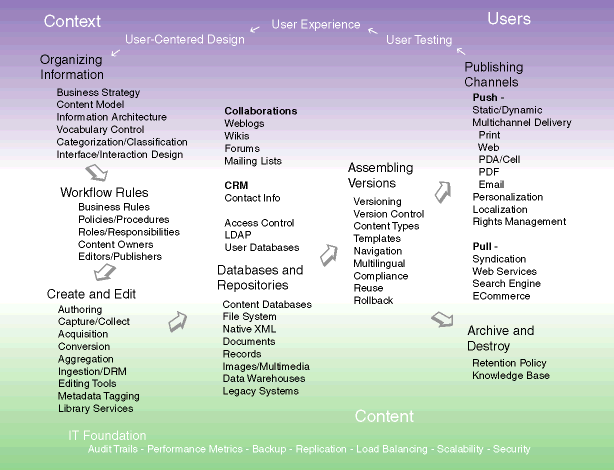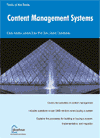Seven Stages of the Content Lifecycle
Content Management is a complex business and is best understood by breaking it down into the major stages or phases involved in managing the content lifecycle.
The best-known content management books, reports, and organizations describe various numbers of stages of the content management process. They are of course all describing the same process, but divide the stages up differently.
Bob Boiko's Content Management Bible and Gerry McGovern's Content Critical see three stages. JoAnn Hackos' Content Management for Dynamic Web Delivery argues for four. Ann Rockley's Managing Enterprise Content suggests five, as does the popular poster from AIIM (The Enterprise Content Management Association). Tony Byrne of CMS Watch identifies only two in his CMS Report.
Tony Byrne distinguishes two main "phases" of CM - Production and Delivery.
Bob Boiko's Content Management Bible (p. 81) emphasizes three "major parts" of a CMS: Collect (creation and editing is much more than simply collecting), Manage (workflows, approvals, versioning, repository, etc.), and then Publish. Bob's Metatorial.com also offers a poster of this process. The three-pronged approach is echoed in the work CM Pros has done to define a markup language for describing a CMS (CMSML).
Gerry McGovern (p. 222 of Content Critical) also sees three "processes," but designates them Creation, Editing, and Publishing.
JoAnn Hackos (p. 60 of Content Management for Dynamic Web Delivery) argues for four "components" - Authoring, Repository, Assembly/Linking, and Publishing.
Ann Rockley (the president of CM Professionals) stresses in her five-column diagram (p.312 of Managing Enterprise Content) that Authoring must save its content elements with metadata for appropriate reuse, but she too prefers Authoring, Repository, Assembly, and Delivery. Rockley also adds Archives to allow access to previous versions and track changes over time, so her categorizations map well onto the five in the AIIM diagram.
While they differ on naming conventions and specifics, all of these CM authors include the central management tools of access control, version control, editing, workflow, staging, personalization, and localization--and AIIM does too. But it seems that there are some big things missing in AIIM's picture of the CM process, such as content modeling, developing the metadata, information architecture, creating taxonomies, and navigation design--not to mention usability, user research, and the user experience. We might collect all of these under a stage of the content lifecycle called Organize.
I would like to suggest seven stages or phases of the CM lifecycle for your consideration.
Organization - Workflow - Creation - Repository - Versioning - Publishing - Archives
Related Links
CMS WatchCMS Forum
CMS Wiki
CMS Info
CMS News
CMS Lists
Content Wire
Content Manager (Europe)
Google CMS
DMOZ CMS
Metatorial
Step Two
OSCOM
Organization
Business Strategy/Content Model/Information Architecture/Vocabulary Control/Categorization and Classification/Interface and Interaction Design/Navigation Design/User Centered Design
The missing stage in all the major sources is the organization of information, structuring it where possible, for example using XML or RDF, which allows arbitrary metadata to be added to all information elements. This is the secret that the knowledge managers describe as turning mere data or information into knowledge. It allows information to be retrieved in a number of ways and reused or repurposed in many more.
This is where categories are created, vocabularies are controlled, taxonomic hierarchies are designed, and faceted classification schemes are developed. Without careful structuring, information will be collected haphazardly and put in the wrong places, perhaps never to be found by workers who may need to recreate it at great expense. Importantly, this is the stage where your content strategy is matched to your business strategy by designing it with your users in mind, to insure that they can and will actually use it.
Business Strategy/Content Model/Information Architecture/Vocabulary Control/Categorization and Classification/Interface and Interaction Design/Navigation Design/User Centered Design
The missing stage in all the major sources is the organization of information, structuring it where possible, for example using XML or RDF, which allows arbitrary metadata to be added to all information elements. This is the secret that the knowledge managers describe as turning mere data or information into knowledge. It allows information to be retrieved in a number of ways and reused or repurposed in many more.
This is where categories are created, vocabularies are controlled, taxonomic hierarchies are designed, and faceted classification schemes are developed. Without careful structuring, information will be collected haphazardly and put in the wrong places, perhaps never to be found by workers who may need to recreate it at great expense. Importantly, this is the stage where your content strategy is matched to your business strategy by designing it with your users in mind, to insure that they can and will actually use it.
Workflow
Business Rules/Policies and Procedures/Roles and Responsibilities/Content Owners/Editors and Publishers/Casual Contributors
Many hands and eyes may work on your content, some highly skilled editors and graphic artists, others will be subject matter experts or those with tacit knowledge you captured to inform your business processes. For this to succeed, you must have carefully designed but flexible rules that keep the content moving, consistent with your business requirements and rules, your policies and procedures.
Business Rules/Policies and Procedures/Roles and Responsibilities/Content Owners/Editors and Publishers/Casual Contributors
Many hands and eyes may work on your content, some highly skilled editors and graphic artists, others will be subject matter experts or those with tacit knowledge you captured to inform your business processes. For this to succeed, you must have carefully designed but flexible rules that keep the content moving, consistent with your business requirements and rules, your policies and procedures.
Creation
Authoring/Capture/Acquisition/Aggregation/Conversion/Ingestion/DRM/Editing Tools/Metadata Tagging
Whether your information is typed into your system by technical writers or ingested by special programs that reach out via Web service connectors to aggregate vast reams of data, this is the stage that classifies everything into the architectural categories designed in stage one.
Authoring/Capture/Acquisition/Aggregation/Conversion/Ingestion/DRM/Editing Tools/Metadata Tagging
Whether your information is typed into your system by technical writers or ingested by special programs that reach out via Web service connectors to aggregate vast reams of data, this is the stage that classifies everything into the architectural categories designed in stage one.
Repositories
Storage/File System/Database/Documents/records/Images/Multimedia/Legacy Systems
Will your content reside entirely in relational database structures, in file system objects, or a hybrid of both? Will it be stored as unstructured text and binary graphic images, or as XML elements tagged with the metadata from stage one? Will the system manage documents and records in their original physical form?
Storage/File System/Database/Documents/records/Images/Multimedia/Legacy Systems
Will your content reside entirely in relational database structures, in file system objects, or a hybrid of both? Will it be stored as unstructured text and binary graphic images, or as XML elements tagged with the metadata from stage one? Will the system manage documents and records in their original physical form?
Versioning
Version Control/Checkin-CheckoutTemplates/Multilingual/Reuse/Rollback
Content changes and presentation changes. Not everyone can make a change on the same document at the same time. You must work around conflicts and be ready to rollback critical content when inevitable errors creep in.
Version Control/Checkin-CheckoutTemplates/Multilingual/Reuse/Rollback
Content changes and presentation changes. Not everyone can make a change on the same document at the same time. You must work around conflicts and be ready to rollback critical content when inevitable errors creep in.
Publishing
Delivery/Multi-Channel/Personalization/Syndication/User Testing/User Experience
Your finished content will be delivered to users in many ways. Some you will push on a schedule, other information will be pulled by users as needed. Some will be traditional print, most via the Web or email, some over mobile devices like PDAs and cellphones. All of these delivery methods must be tested to insure the quality of user experience that stage one was preparing you for.
Delivery/Multi-Channel/Personalization/Syndication/User Testing/User Experience
Your finished content will be delivered to users in many ways. Some you will push on a schedule, other information will be pulled by users as needed. Some will be traditional print, most via the Web or email, some over mobile devices like PDAs and cellphones. All of these delivery methods must be tested to insure the quality of user experience that stage one was preparing you for.
Archives
Knowledge Base/Retention/Preservation/Destruction
Although publishing is probably your major objective, not all your content is ephemeral. Some must be protected to comply with internal or external requirements, some eliminated for similar reasons. Some may be so valuable you must make it part of your "institutional memory." It captures the business knowledge of your organization, allowing it to be shared with ever-changing generations of workers. It becomes your permanent knowledge base.
Knowledge Base/Retention/Preservation/Destruction
Although publishing is probably your major objective, not all your content is ephemeral. Some must be protected to comply with internal or external requirements, some eliminated for similar reasons. Some may be so valuable you must make it part of your "institutional memory." It captures the business knowledge of your organization, allowing it to be shared with ever-changing generations of workers. It becomes your permanent knowledge base.








